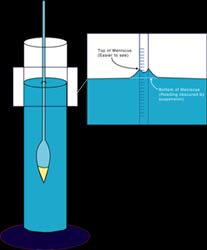 |
|
Figure 4. Rationale for correction on meniscus reading when determining composite correction.
(Click for larger image)
|
Hydrometer readings are affected by the specific gravity of the solution, the temperature of the solution, and where the scale is read (top or bottom of the meniscus). All these considerations necessitate a “composite” correction on hydrometer readings for the sample in question. AASHTO T88 recommends preparing a “blank” sample in a sedimentation cylinder (using the same proportion of solution and distilled water as would normally prevail for the sample cylinder) at a controlled (or several controlled) temperature(s) in order to ascertain what the “correction” factor for thereading on the scale should be. This may done over an anticipated range of temperatures in order to determine the effect on actual readings during the test, or a companion blank may be tested at the same time as the test sample.
Hydrometer scales are designed to be read at the bottom of the meniscus (see Figure 7). Because this is not possible with soil suspensions (the discolored water does not allow you to read the scale on the hydrometer at the bottom of the meniscus), the top of the meniscus should be read and a correction factor applied. When using hydrometer 152 H the composite correction is the reading at the top of the meniscus in the “blank” sample minus zero.
![]()